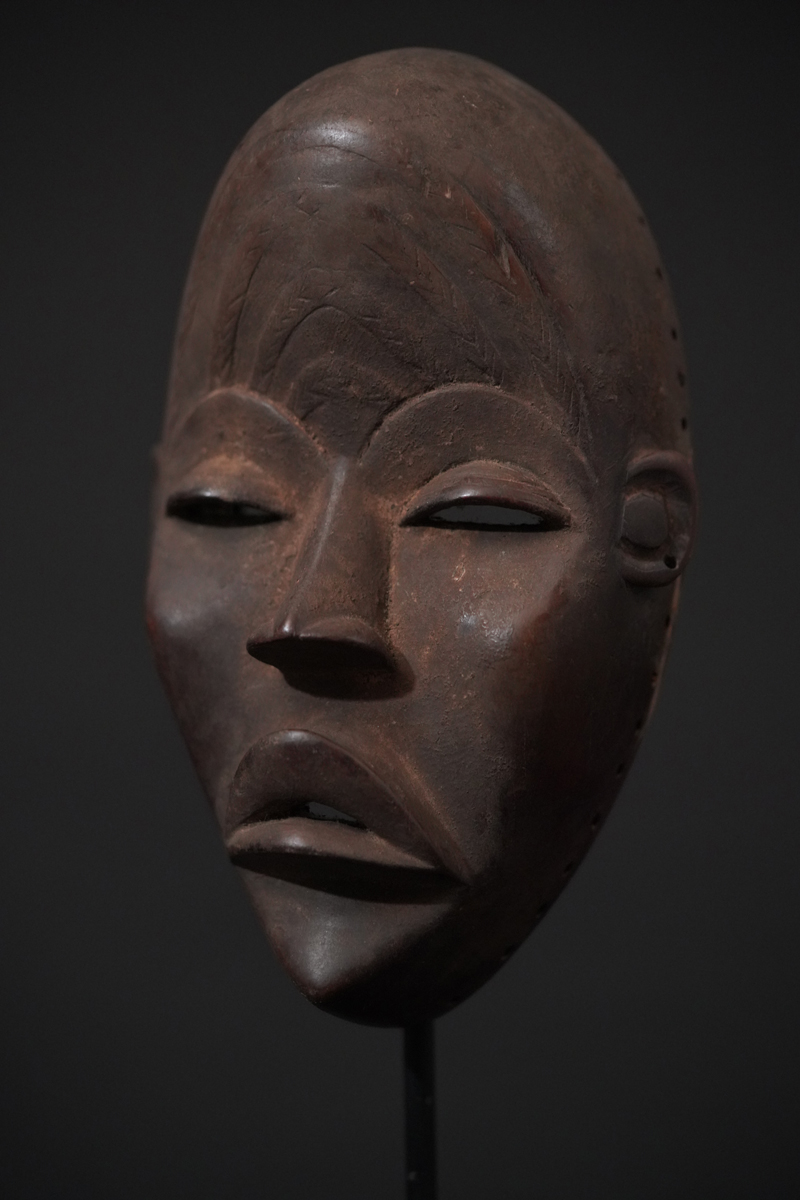|
A Dan Tura mask from the region of Biankouma, oval shaped with pointed chin, full lips, mouth slightly open, downturned corners of the mouth, high cheekbones, the nose straight, the almond-shaped half-closed eyes with notched eyelids, likewise the curved brows, arched scarifications in a plait pattern on the forehead, almost circular ears, the mask pierced at the rim; the patina in layers in different shades of brown, signs of use and age. Provenance Mohamed Belo Garba. The Dan Tura masks from Liberia have become one of the most sought-after Dan masks. Their recognition value is high, although in the conventional literature only pieces from the periphery of these probably most important Dan masks are shown. See in the Rietberg catalogue p. 133, fig. 166, which Hans Himmelheber collected in the 1950s. In the Rietberg catalogue "Afrikanischer Meister", Zurich 2016, none of the examples of this important Dan mask style is represented. These masks only became known to a greater extent through our publications on the internet, where we have so far presented 5 examples of this carving style. Himmelheber schreibt zum Erscheinungsbild der Dan-Masken: "Der Unterschied zwischen einer männlichen und einer weiblichen Maske ist so groß, dass wir sie fast für Masken aus verschiedenen Stilgebieten halten könnten. Die weiblichen Masken haben ovale Form, die männlichen mehr drei- oder fünfeckige Form, wobei die Stirn die Basis des Dreiecks ist." Die Augen der weiblichen Masken sind "schmale Schlitze, weil es zum Schönheitsideal dieser Völker gehört, dass man das Auge der Frau nur ganz wenig unter den Lidern sieht." Himmelheber in: Masken der Wè und Dan - Elfenbeinküste. Museum Rietberg, Zürich, 1997, s. 19, Abb. 8 und s. 20. Himmelheber writes about the appearance of the Dan masks: "The difference between a male and a female mask is so great that we could almost mistake them for masks from different styles. The female masks are oval in shape, the male more triangular or pentagonal, with the forehead being the base of the triangle." The eyes of the female masks are "narrow slits, because it is part of the ideal of beauty of these peoples that the eye of the woman is seen very little under the eyelids." Himmelheber in: Masken der Wè und Dan - Elfenbeinküste. Museum Rietberg, Zürich, 1997, p. 19 no. 8 and p. 20. Lit.: Eberhard Fischer/Hans Himmelheber: The Arts of the Dan in West Africa, Museum Rietberg, 1984; Hans Himmelheber: Masken der We und Dan - Elfenbeinküste, Museum Rietberg, Zürich, 1997; Eberhard Fischer: Meisterbildhauer der Dan im 20. Jahrhundert. sold Height: 24 cm
|
 photo: wolfgang-jaenicke.com, for more information, please write us an e-mail with the identification number of the photo identification no. BBC08406.jpg |